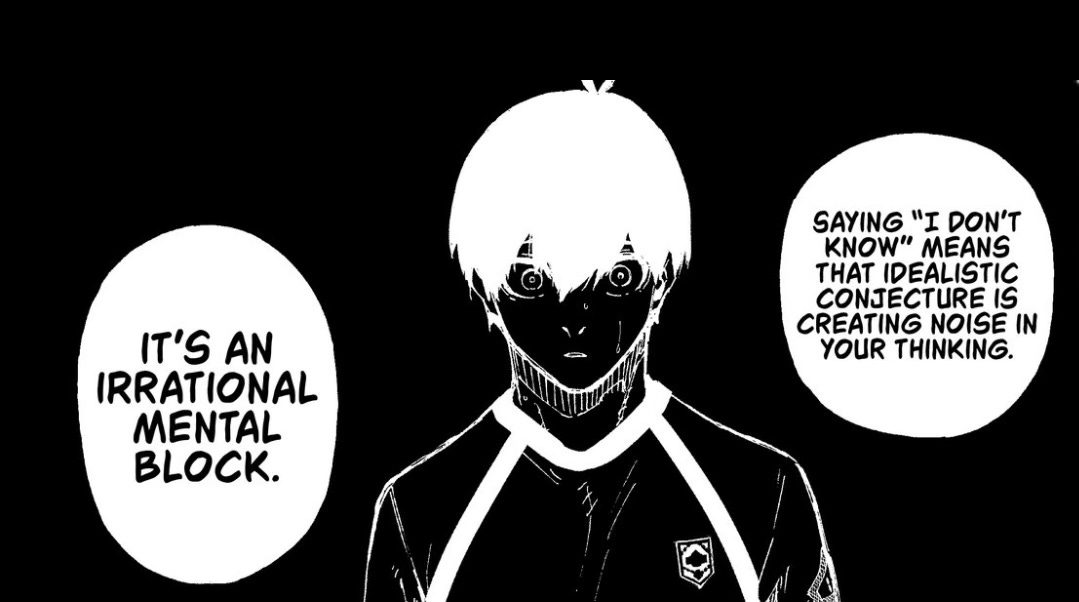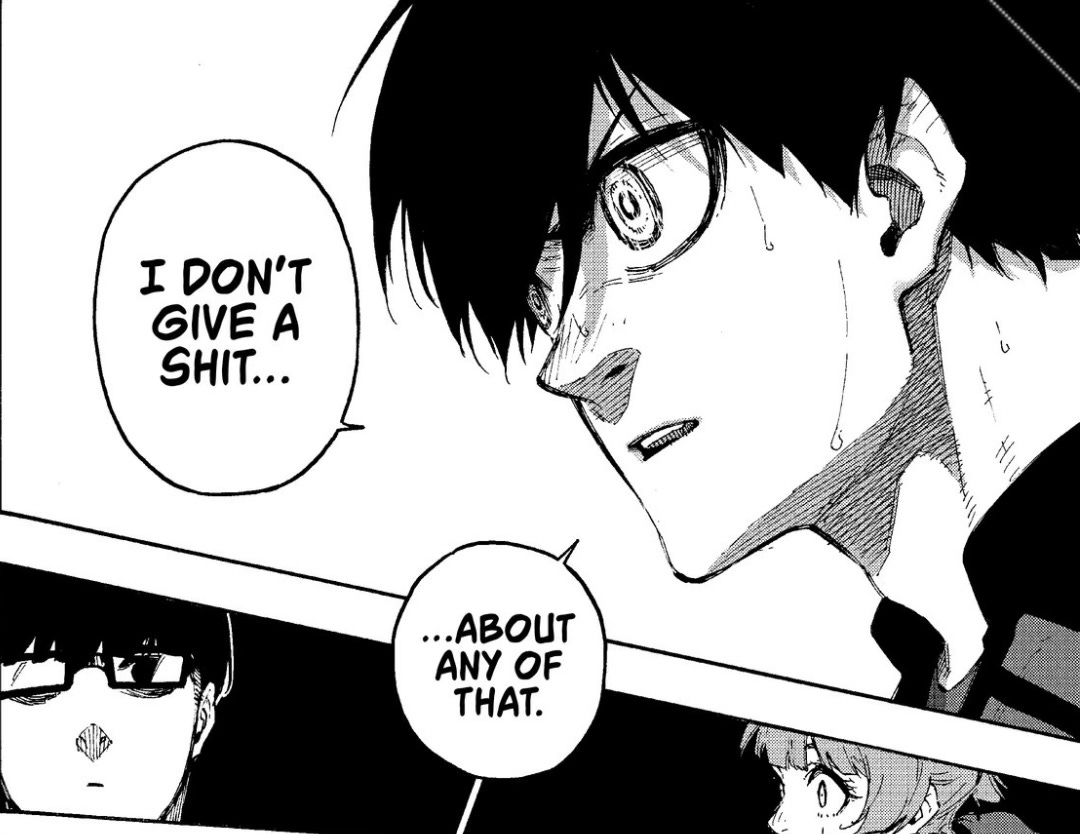Preface!
I feel the need to preface this by saying that I’ve gone deeper down the Blue Lock rabbit hole than I’ve ever gone before. So much so that there may or may not be a logo for a hypothetical podcast called Blue Locked on my computer desktop. No further comment on that for now.
But for all my trumpeting, I stand by the fact that as a muse, Blue Lock reigns supreme. However you approach this story, whatever you’re looking for, you will find it.
That’s a rare narrative. Pick any storytelling element, take it to Blue Lock and you will learn something.
Bet.
Preface over.
I’ve mentioned the semi-egotistical fact that I’ve coined writing theories here before. The Snapshot Theory, for instance, or the use of openings as a line of credit. Well, in the spirit of Blue Lock, I’m going to level up my own ego (Barou would be proud) and introduce a new writing theory right here, right now.
I call it, as the title betrays: Fields of Growth. And, I’ll add, I’m not even sure I’m fully on board with this concept yet, but let’s explore it together and see what happens.
One of the remarkable—and remarkably easy to track—things that Blue Lock consistently does is it creates a clearcut arena with which to see and track character growth. That arena is the field of play—the soccer pitch. In any given match in the Blue Lock series, if players are on the field, facing adversity and obstacles and heroes of a different motivation on the other team (see what I did there?), they will consistently face the possibility of “leveling up,” or growing as a character.
Doesn’t mean they’re always going to take it. Naruhaya, for instance, faced his obstacle and lost. Isagi faces it and fails when he loses to Rin. Reo faces it and fails when he loses to Nagi. All part of the growth process, all happening on a field of growth.
But they only ever grow on the playing field. Outside of those moments, those pinpoint opportunities for growth, it’s just a good time. They’re eating and talking and in the bath (a lot), perhaps thinking about the possibility of growth and improvement, but not actually taking those steps. Those steps are not taken until they enter the field… the field of growth.
Perhaps this is a “me” thing, but I love character growth so much that it stresses me out. When I’m writing a character, I feel like I need to constantly track their arc. To hyper-analyze any given moment and make sure it tracks and means something. If they choose ketchup on their hot dog in their first dinner scene, what does it mean that they choose mustard in their twelfth dinner scene?
So many pieces to connect, and that spirals into how I look at other stories too. I assume other writers are putting the same incessancy into their character arcs.
But what if they aren’t?
What if, like Blue Lock, character growth really can be narrowed down to specific moments, with everything else serving as the lines that connect the dots? If character growth is a chart, there are lines and dots, yeah? Dots being the moments the lines change direction.
The only logical thing I could do, upon meeting this concept, was test it against other mainstream narratives.
We’ll start with Star Wars. Luke Skywalker. When does he really grow? Well, in A New Hope, he grows when his aunt and uncle get barbecued. And this makes sense as a field of growth, because he’s just faced some pretty significant adversity. He grows when he’s training with Obi-Wan. That’s a pretty obvious field of growth. He grows when he puts down his scope and trusts the force to destroy the Death Star. Another pretty obvious field of growth.
What’s he doing in between those moments?
He’s not necessarily growing, so much as he’s solidifying a previous growth. Again, the line between the dots, if you will. After the barbecue of his aunt and uncle, he has anger, frustration. He wants revenge. That’s a growth, even if it’s not positive. It expands the depth of his emotion. And it’s up to Obi-Wan to curb that growth into something more useful. When he is training with Obi-Wan, he’s growing more positively in another direction, but his frustration is still there. Then when he destroys the Death Star, again, a big field of growth no matter how it turns out, his previous growths have subsided and he’s able to fully “level up.”
Let’s look at Lord of the Rings and fixate on Frodo Baggins and his fields of growth.
When presented with a deadly ring that can literally change the fate of the world, that’s a field of growth. When he’s at a council with all the fancy folk from around Middle Earth talking about what to do with this ring, that’s a field of growth. When he’s in the depths of Moria and sees his friendly neighborhood wizard supposedly die, that’s a field of growth. From each of those moments, something big happens in his character. He decides to take the ring. He doubles down on his decision to take the ring, and then he resolves to take the ring on his own.
These are big points on a timeline. When he meets the ring for the first time, he grows to rise to the occasion. When at the council, the same applies, he rises to the occasion. When he sees Gandalf fall, he knows sorrow like he never has before. When he’s on the banks of the river and the Fellowship is fighting bands of Uruk-hai, Frodo enacts his plan to go on this quest alone.
All huge points of growth, but prompted by being put in a field of growth. What’s he doing in between? Walking, talking, fighting, screaming, nearly dying, kicking dirt and ash on tomatoes. He’s moving, but is he comprehensively growing? Not necessarily. Not until faced with a big threat, a profound loss, a decisive moment.
And that’s the key to these fields of growth. Just like in real life, when we’re put in a big situation that requires a big reaction—either emotionally, physically, mentally, spiritually, whatever—we are in a field of growth. We’re going to grow one way or another.
Same with Frodo, Luke Skywalker, Isagi—putting them in a high-stakes situation, a field of growth, and that’s where the growth occurs.
The more I’ve explored this, the more it resonates with battle-centered manga as well. Characters can train all they want, they can learn more about themselves, but until they step onto a field of battle—also known, as of this moment, as a field of growth—they aren’t able to really grow.
Which is part of the reason I love Wind Breaker so much too. It’s an action-based manga, but the fields of growth aren’t really the battlefields. Actually, it’s far more likely to be a field of growth when Sakura is sitting at the diner with his friends, talking about his conflicted emotions. That’s when he takes what he experienced on the battlefield and applies it to growth. Wind Breaker, like Blue Lock, is a master muse, it inverts everything with superb effect, and just because I love it so much, here are two other pieces I’ve written about it:
Blue Lock makes this easier to see than any other story because the fields all look the same. Start mixing things up like Wind Breaker does, and character growth isn’t as readily apparent. You know these characters are growing, but you have to look a bit harder to find the when’s and the where's.
In Episode Nagi, we see the same from the character of Nagi, and it’s the same case. His big character arc is all about motivation. How will he find passion. He only ever finds it when he’s on the soccer pitch. From the first time he steps on with Reo, he begins this journey, and every dot on his development graph takes place on a pitch. When he sees Isagi play for the first time, when he runs into Reo again, when he first realizes how much he loves soccer. All on fields of growth. All on soccer fields.
So what’s the takeaway? Well, for me personally, I’m aiming to use this to help me not be so stressed about character growth. If I can identify the opportune moments to have a character grow, I can focus on the importance of those moments that form the dots on the graph and worry less about character decisions in the lines in between.
Hey, creatives—pick any character you’ve written and look at their growth moments. Bonus points if you want to graph it out. Can you see their growth? if so—great, you rock. If not—try creating another field of growth, a big moment they have to face, where they have to be a better version of their previous self.
Hey, fans of Blue Lock—I gave Haikyu!! a peruse, made it through 50 chapters or so, and just can’t read other sports manga while Blue Lock is so captivating. How do you feel it stacks up to other sports manga?









